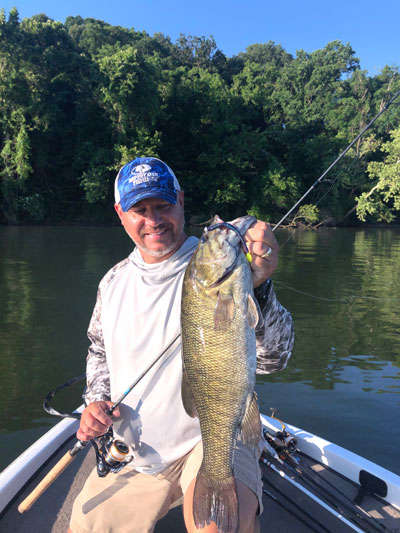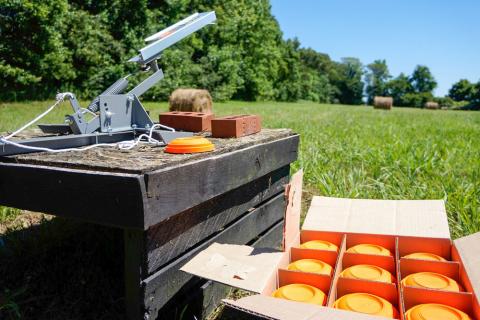provided by John Phillips
One of the best big smallmouth bass waters is the Tennessee River, especially the southern half that runs through north Alabama, west Mississippi and south Tennessee. The two lakes that get the most publicity and produce the biggest smallmouths are Pickwick and Wilson lakes. However, these two lakes not only produce great smallmouth fishing, but equally as good, if not better, largemouth, spotted, hybrid saltwater and striped bass fishing and catfishing. Brad Whitehead of Muscle Shoals, Alabama, guides for smallmouths and other fish. To learn more about Whitehead, visit his Facebook page.
 Just because you’ve hooked the smallmouth, the rod is bending, and you’ve got the fish on the end of the line, doesn’t mean that smallmouth is caught. Getting the smallmouth in the boat starts with the hook set. When I feel the bite, I take up slack and try and sweep the hook into the smallmouth’s mouth, rather than jerk the hook into its mouth. By sweeping the hook, the live bait hook turns and gets in the side of the fish’s mouth. That’s the best place the hook can be to prevent the smallmouth from throwing the hook - either while it’s fighting or jumping.
Just because you’ve hooked the smallmouth, the rod is bending, and you’ve got the fish on the end of the line, doesn’t mean that smallmouth is caught. Getting the smallmouth in the boat starts with the hook set. When I feel the bite, I take up slack and try and sweep the hook into the smallmouth’s mouth, rather than jerk the hook into its mouth. By sweeping the hook, the live bait hook turns and gets in the side of the fish’s mouth. That’s the best place the hook can be to prevent the smallmouth from throwing the hook - either while it’s fighting or jumping.
When you first start fishing, you want to set the drag on your reel, so that if you get on a big fish, the reel will give up line. You need to keep constant pressure on the line from the time you sweep the hook to the corner of the fish’s mouth, until it’s in the boat. If you have time to think through what you’re supposed to do, there won’t be a problem. However, when you see a 5 to 6-pound smallmouth’s tail walking in the air, remembering to keep pressure on the line is often forgotten, even for veteran anglers.
On the Tennessee River, our average smallmouth during the summer months will weigh 3 to 4 pounds, but we regularly catch smallmouths that weigh 5 pounds and occasionally 6 or 7 pounders. Even though you’re fishing for smallmouths, you’ll catch every other fish that swims in the Tennessee River too. That’s what makes this type of fishing a lot of fun. It’s not uncommon for anglers to catch 50 or 60 fish of many varieties in a day of fishing on the Tennessee River with live bait when a current is running. Our normal guide trips are about 6 hours long. When an angler has caught 50-60 fish in 6 hours, they’re about ready to go home.
Another bass that you’ll catch at the Tennessee River in the summertime is what we call a mean mouth - a crossbreed bass between a smallmouth and a spotted bass. You’ll probably catch and release 100 pounds every trip of bream, enough catfish for a fish fry, hybrid striped bass and saltwater stripers. On summertime live-bait trips at the Tennessee River, your rod will be bent about 99 percent of the time you’re fishing, and you keep what you want to eat. What I’ve described so far is mainly found on Wilson Lake. The lake below it is Pickwick Lake that’s more of a traditional river-run lake. You’ll find shell mounds, pea gravel banks, sand banks and underwater Indian mounds at Pickwick Lake.






























